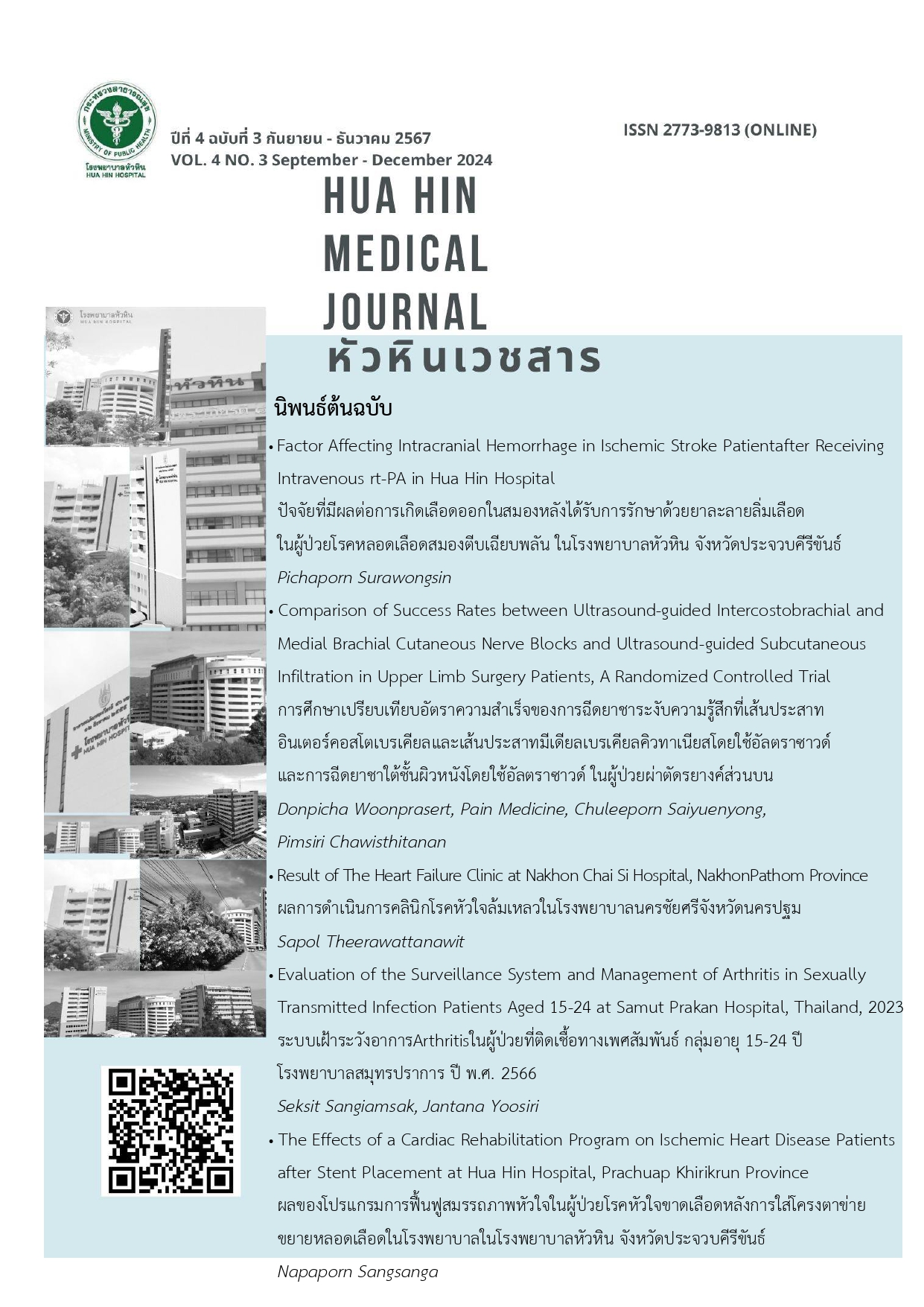Factor Affecting Intracranial Hemorrhage in Ischemic Stroke Patient after Receiving Intravenous rt-PA in Hua Hin Hospital
Keywords:
Ischemic stroke, Intravenous recombinant tissue plasminogen activator (IV rt-PA), Intracranial hemorrhageAbstract
Background: The incident of ischemic stroke in Thailand is increasing and leading to higher morbidity and mortality. The standard treatment of ischemic stroke onset lease than 4.5 hours is intravenous thrombolytic or IV rt-PA. The most serious complication of IV rt-PA is intracranial hemorrhage that is resulting to more disability and death of ischemic stroke patient.
Objective: This research attempts to find out factor associated with increasing risk of intracranial bleeding after receiving IV rt-PA in ischemic stroke patient at Hua Hin Hospital.
Method: This study is retrospective analytical study. The data are collected from medical records of patients who diagnosed with acute ischemic stroke and receiving IV rt-PA during the period from 1 January 2020 to 31 December 2022. The data are analyzed by Logistic regression analysis.
Results: A total number of ischemic stroke patient who receiving IV rt-PA is 84 and the incident of intracranial hemorrhage is 15 or 17.85%. The factor that we comparing are sex, age, underlying disease, atrial fibrillation, using of antiplatelet and anticoagulant, blood pressure, NIHSS score, onset to rt-PA, creatinine, blood sugar, coagulogram, platelet count. The factor associated with intracranial hemorrhage is platelet number (adj.OR 15.94, 95%CI 1.84 - 138.18, P=0.012). The factor that possibly be associated are NIHSS score more than 13 (adj.OR 3.24, 95%CI 0.86 - 12.15, P=0.082), time onset to rt-PA more than 210 min (adj.OR 2.61, 95%CI 0.68 - 10.07, P=0.164).
Conclusion: The Factor affecting intracranial hemorrhage in ischemic stroke patient after receiving intravenous rt-PA in Hua Hin Hospital is platelet level.
References
สมศักดิ์ เทียมเก่า. สถานการณ์ โรคหลอด เลือดสมอง. วารสารประสาทวิทยาแห่งประเทศไทย.2021;4(37):54-60.
Powers, W. J., et al. Guidelines for the Early Management of Patients With Acute Ischemic Stroke: 2019 Update to the 2018 Guidelines for the Early Management of Acute Ischemic Stroke: A Guideline for Healthcare Professionals From the American Heart Association/American Stroke Association Stroke.2019;50(12).
Teekaput C, Thiankhaw K, Tanprawate S, Teekaput K, Chai-Adisaksopha C. Outcomes of asymptomatic recombinant tissue plasminogen activator associated intracranial hemorrhage. PLoS One. 2022 ;17(8)
Wardlaw JM, Murray V, Berge E, del Zoppo GJ. Thrombolysis for acute ischaemic stroke. Cochrane Database Syst Rev. 2014;2014(7)
Seet RC, Rabinstein AA. Symptomatic intracranial hemorrhage following intravenous thrombolysis for acute ischemic stroke: a critical review of case definitions. Cerebrovasc Dis. 2012;34(2):106-14.
Stead LG, Gilmore RM, Decker WW, Weaver AL, Brown RD Jr. Initial emergency department blood pressure as predictor of survival after acute ischemic stroke. Neurology. 2005;65:1179–1183.
Demchuk AM, Morgenstern LB, Krieger DW, Linda Chi T, Hu W, Wein TH, et al. Serum glucose level and diabetes predict tissue plasminogen activator-related intracerebral hemorrhage in acute ischemic stroke. Stroke. 1999;1:34-9.
Wahlgren N, Ahmed N, Eriksson N, Aichner F, Bluhmki e, Davalos A, et al. Safe implementation of Thrombolysis in Stroke-MOnitoring Study Investigators..Mutlivariable analysis of outcome predictors and adjustment of main outcome results to baseline data profile in randomized controlled trials: Safe Implementation of Thrombolysis in Stroke-Monitoring Study (SITS-MOST). Stroke. 2008;1
Xie X, Yang J, Ren L, Hu S, Lian W, Xiao J, Pan L, Deng L, Ma J. Nomogram to Predict Symptomatic Intracranial Hemorrhage after Intravenous Thrombolysis in Acute Ischemic Stroke in Asian Population. Curr Neurovasc Res. 2021;18(5):543-551
Dharmasaroja PA, Meungtaweepongsa S, Pattaraarchachai J, Dharmasaroja P. Intracerebral hemorrhage following intravenous thrombolysis in Thai patients with acute ischemic stroke. J Clin Neurosci. 2012 Jun;19(6):799-803.
Zhu J, Shen X, Han C, Mei C, Zhou Y, Wang H, Kong Y, Jiang Y, Fang Q, Cai X. Renal Dysfunction Associated with Symptomatic Intracranial Hemorrhage after Intravenous Thrombolysis. J Stroke Cerebrovasc Dis. 2019 Nov;28(11)
Tanne D, Kasner SE, Demchuk AM, Koren-Morag N, Hanson S, Grond M, et al. Markers of increased risk of intracerebral hemorrhage after intravenous recombinant tissue plasminogen activator therapy for acute ischemic stroke in clinical practice: the Multicenter rt-PA Stroke Survey. Circulation. 2002 Apr 9;105(14):1679-85.
Zhu J, Shen X, Han C, Mei C, Zhou Y, Wang H, Kong Y, Jiang Y, Fang Q, Cai X. Renal Dysfunction Associated with Symptomatic Intracranial Hemorrhage after Intravenous Thrombolysis. J Stroke Cerebrovasc Dis. 2019 Nov;28(11)
Tanne D, Kasner SE, Demchuk AM, Koren-Morag N, Hanson S, Grond M, et al. Markers of increased risk of intracerebral hemorrhage after intravenous recombinant tissue plasminogen activator therapy for acute ischemic stroke in clinical practice: the Multicenter rt-PA Stroke Survey. Circulation. 2002 Apr 9;105(14):1679-85.
Downloads
Published
How to Cite
Issue
Section
License
Copyright (c) 2024 Hua-Hin Hospital

This work is licensed under a Creative Commons Attribution-NonCommercial-NoDerivatives 4.0 International License.
บทความที่ได้รับการตีพิมพ์ในวารสารหัวหินเวชสาร เป็นลิขสิทธิ์ของโรงพยาบาลหัวหิน
บทความที่ลงพิมพ์ใน วารสารหัวหินเวชสาร ถือว่าเป็นความเห็นส่วนตัวของผู้เขียนคณะบรรณาธิการไม่จำเป็นต้องเห็นด้วย ผู้เขียนต้องรับผิดชอบต่อบทความของตนเอง







